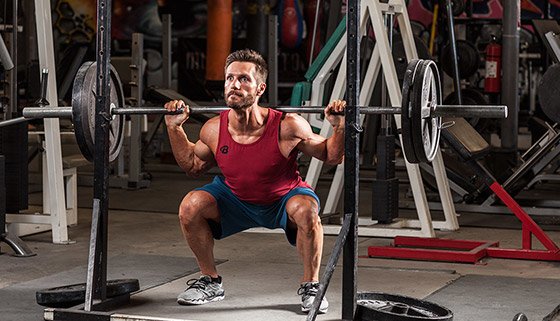Most experienced gym rats align themselves with one of two training modalities: powerlifting or bodybuilding. The goal is either strength or size. While a dichotomy exists between the training styles, there also exists a middle ground in which they're complementary. Here, strength is used to build size.
Once a lifter has passed the beginner stage, his or her body needs greater amounts of stress to continue growing. There are numerous advanced hypertrophy techniques to choose from, but when approached from a strength standpoint instead the size equation remains simple: Lift the most weight possible while employing the greatest volume possible. What's possible, in this instance, is governed by recovery.
Increased strength can be a catalyst for increased muscle mass, but it requires a specific toolkit and training approach. How, then, do you use strength to build size? By using these training-tested techniques approved by powerlifters and bodybuilders all over the globe!
1
Cluster Sets
Cluster sets utilize rest between reps to help you accrue a total amount of reps with a heavier weight than is normally possible in a straight set.

To perform a cluster set of, say, 5 reps, you employ 5 single reps with 20 seconds between each rep until 5 total reps are achieved. In other words, do one rep, rest 20 seconds, do another rep, rest 20, and continue in this fashion until you've completed all your reps. Clustering reps like this allows you to achieve more volume per set with weights you normally couldn't use for that many reps.
For example, let's say you can bench press 225 pounds for a straight set of 3 reps. By adding rest between reps, you could add 2 more reps to the set and press 225 for 5 total reps. Heavy weight for more volume equals bigger muscles.
This, of course, isn't the only way to arrange your cluster set; clusters of 2 and 3 reps are also useful depending on the application.
Cluster sets can be arranged in two ways: to load the day's main lift, or to extend the day's main lift. Let's explain using examples.
Loading the Main Lift |
|||||
| Exercise | Total Sets | Total Reps Per Set | Clusters @ % 1RM | Rest Between Clusters | Rest Between Sets |
| Squat | 3 | 8 | 4 x 2 @ 85% | 20 seconds | 2 minutes |
You wouldn't normally be able to do 8 straight reps with 85 percent of your 1-rep max (1RM), especially for 3 sets. But here your 8 reps are broken down into four 2-rep clusters per set, so you squat 85 percent of your 1RM for 8 reps. This allows you to achieve greater volume with heavier weight and build more muscle!
Extending the Main Lift |
|||||
| Exercise | Total Cluster Sets | Total Reps Per Set | Clusters @ % 1RM | Rest Between Clusters | Rest Between Sets |
| Squat | 2 | 5 | 2x2, 1x1 @ 85% | 20 seconds | 2 minutes |

Clusters are also great for extending your main lift, which would first be done with straight sets. To put this into practice, let's say you complete 4 straight sets of 3 reps on the squat, but you want to continue to build volume with that lift. Extend your main lift by adding cluster sets after your straight sets. This cluster application works well during heavy, absolute-strength-training phases. The weight is kept heavy to build strength while also engaging size-building volume.
When using clusters to extend your main lift, use the same weight you did for your straight sets. (In some cases, slightly more.) This ensures you achieve more hypertrophy by amassing volume with heavier loads.
In the example above, your cluster set would consist of 2 sets of 2 reps and a set of 1 rep, each set separated by 20 seconds rest. After you complete all 5 reps, rest two minutes before completing a second time (two total cluster sets).
2
Heavy Eccentrics (Negatives)
Hypertrophy fanatics often espouse time-under-tension's muscle-building virtues. Their enthusiasm isn't unwarranted—increasing a muscle's time under tension promotes growth. What's key, however, is keeping the intensity high while maintaining the tension. Heavy eccentrics, sometimes called negatives, tap into your strength and provide that key.
Eccentric muscle contractions—lowering a weight rather than lifting it—are the most damaging. As a result, eccentrics trigger the most inflammation and have an increased propensity to restructure muscle. If you create a lot of muscle damage, your body will adapt by adding more muscle so the same stimulus isn't as damaging the next time around.
But the process requires heavy weight. Light eccentrics teach control, but creating a disruption that will build muscle requires intensity to the tune of 75-85 percent of 1RM. (Unless you have a trained and dedicated spotter, I wouldn't recommend using 90 percent or more of your 1RM for extended eccentrics.)
You'll lower these heavy loads during eccentric phases for as long as 4-6 seconds while completing 3-6 reps in this manner per set. As the load increases, you'll extend the length of the eccentrics and decrease the reps per set.
Exercise selection is paramount: You must choose exercises that have a pronounced eccentric phase. Squat variations, bench-press variations, rowing variations, and Romanian deadlifts work best.

Heavy eccentrics are well-suited for loading main and assistance lifts. Here's a programming snapshot of each.
Heavy Eccentric Main Lift |
|||||
| Exercise | Total Sets | Total Reps Per Set | Length of Eccentric | Percent of 1RM | Rest Between Sets |
| Bench Press | 5 | 3 | 5 seconds | 80% | 2 minutes |
The reps per set are kept low and the eccentric contraction is kept in the mid-range timeframe because the load is at 80 percent of one-rep max. The eccentric could stay at five seconds as the load is increased to 85 percent, but it's often advantageous to decrease the length to four seconds to maintain quality reps. Doing 5 sets supplies a total volume that spurs adaptation.
Heavy Eccentric Assistance Lift |
|||||
| Exercise | Total Sets | Total Reps Per Set | Length of Eccentric | Percent of 1RM | Rest Between Sets |
| Dumbbell Bench Press | 3 | 5 | 6 seconds | 75% | 90 seconds |
Assistance eccentrics require a few programming alterations. Total volume remains, but we're dropping the load and increasing the length of the eccentric phase. These alterations maintain muscle-building stress while preserving the nervous system. If you keep the load high, it's likely that your nervous system would receive more input than it could handle. The result is overtraining accompanied by minimal gains.
Heavy eccentrics are a great loading choice to apply early in your training season. They build muscle and soft-tissue resiliency while setting the neurological stage for big strength gains. This takes place, of course, as you pack mass on your frame.
Build Strength, Get Big
In the end, size and strength training aren't always mutually exclusive; hypertrophy is often the result of strength-building strategies. If you've surpassed the basics, it's time to employ these lifter-tested techniques to gain new levels of mass and strength.
Recommended For You

Mind Over Muscle: Your One-Rep Max Mental Checklist
Stepping up to the barbell for a new PR? Here's your 5-step mental checklist for crushing your one-rep max!
Build Strength From Your Feet
Build a stronger squat and deadlift by focusing on your foot position. Here's an approach that will help you put your strongest foot forward!

